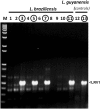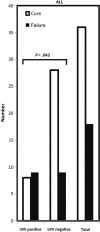Association of the Endobiont Double-Stranded RNA Virus LRV1 With Treatment Failure for Human Leishmaniasis Caused by Leishmania braziliensis in Peru and Bolivia
- PMID: 26123565
- PMCID: PMC4676543
- DOI: 10.1093/infdis/jiv354
Association of the Endobiont Double-Stranded RNA Virus LRV1 With Treatment Failure for Human Leishmaniasis Caused by Leishmania braziliensis in Peru and Bolivia
Abstract
Cutaneous and mucosal leishmaniasis, caused in South America by Leishmania braziliensis, is difficult to cure by chemotherapy (primarily pentavalent antimonials [Sb(V)]). Treatment failure does not correlate well with resistance in vitro, and the factors responsible for treatment failure in patients are not well understood. Many isolates of L. braziliensis (>25%) contain a double-stranded RNA virus named Leishmaniavirus 1 (LRV1), which has also been reported in Leishmania guyanensis, for which an association with increased pathology, metastasis, and parasite replication was found in murine models. Here we probed the relationship of LRV1 to drug treatment success and disease in 97 L. braziliensis-infected patients from Peru and Bolivia. In vitro cultures were established, parasites were typed as L. braziliensis, and the presence of LRV1 was determined by reverse transcription-polymerase chain reaction, followed by sequence analysis. LRV1 was associated significantly with an increased risk of treatment failure (odds ratio, 3.99; P = .04). There was no significant association with intrinsic Sb(V) resistance among parasites, suggesting that treatment failure arises from LRV1-mediated effects on host metabolism and/or parasite survival. The association of LRV1 with clinical drug treatment failure could serve to guide more-effective treatment of tegumentary disease caused by L. braziliensis.
Keywords: L. braziliensis; RNA viruses; Totivirus; Viannia; antimony drug treatment; drug resistance; drug treatment failure; leishmaniasis.
© The Author 2015. Published by Oxford University Press for the Infectious Diseases Society of America. All rights reserved. For permissions, e-mail journals.permissions@oup.com.
Figures





References
Publication types
MeSH terms
Substances
Grants and funding
LinkOut - more resources
Full Text Sources
Other Literature Sources

